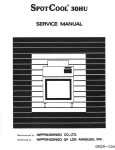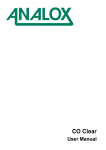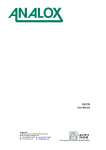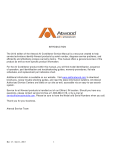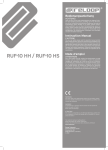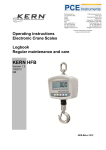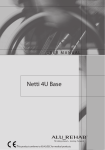Download Service Manual Moffat
Transcript
Service Manual Moffat MTR09YATWW MTR09YATSA MTR09YATCS MTR10YATWW 1 INDEX INTRODUCTION ------------------------------------------------------------------------- 1 COMPRESSION PHASE ------------------------------------------------------ 1 CONDENSATION PHASE ---------------------------------------------------- 2 EXPANSION PHASE ----------------------------------------------------------- 2 EVAPORATION PHASE ------------------------------------------------------- 2 REPAIRS ----------------------------------------------------------------------------------- 3 SECURITY --------------------------------------------------------------------------------- 3 WARNING ------------------------------------------------------------------------- 3 CARE AND RECOMENDATIONS ------------------------------------------ 3 BEFORE CONSIREDERING THAT A SEVICE HAS BEEN ACCOMPLISHED --------------------------------------------------------------- 3 RECOMENDATIONS TO USERS --------------------------------------------------- 4 INSTALLATION --------------------------------------------------------------------------- 4 SYSTEM CHARACTERISTICS ------------------------------------------------------- 5 REFRIGERATING UNIT SYSTEM -------------------------------------------------- 7 COMPRESSOR ------------------------------------------------------------------ 7 AUXILIARY SERPENTINE TUBE ------------------------------------------- 8 CONDENSADOR ---------------------------------------------------------------- 8 CONDENSER TUBE LOOP -------------------------------------------------- 8 DRYER ----------------------------------------------------------------------------- 9 CAPILLARY TUBE -------------------------------------------------------------- 9 EVAPORATOR ------------------------------------------------------------------ 9 SUCTION LINE AND HEAT EXCHANGER ------------------------------ 10 REFRIGERATING UNIT DIAGRAM ---------------------------------------- 11 ELECTRIC AND CONTROL SYSTEM --------------------------------------------- 12 TEMPERATURE CONTROL ------------------------------------------------- 12 DEFROST CONTROL --------------------------------------------------------- 13 DEFROST THERMOSTAT (KLIXON) --------------------------------------14 SOLID STATE RELAY (PTC) ------------------------------------------------ 15 TERMIC PROTECTOR -------------------------------------------------------- 16 DEFROST RESISTANCE ----------------------------------------------------- 16 ELECTRIC AND CONTROL SYSTEM DIAGRAM ---------------------- 17 FAN --------------------------------------------------------------------------------- 19 AIR FLOW DIAGRAM ---------------------------------------------------------- 21 ELECTRIC DIAGRAM ----------------------------------------------------------22 CABINET SYSTEM ---------------------------------------------------------------------- 23 SUPERIOR HINGE ------------------------------------------------------------- 23 INTERMEDIATE HINGE -------------------------------------------------------23 INFERIOR HINGE ---------------------------------------------------------------25 FAILURE LOCATION CHART -------------------------------------------------------- 26 REPLACEABLE PARTS ----------------------------------------------------------------28 2 INTRODUCTION For a refrigerating system to work, it is necessary to make refrigerating go repeatedly through a closed circuit that is basically compound of four phases: Compression, Condensation, Expansion and Evaporation. The refrigerating is circulating all the time when the compressor is working, creating a pressure difference within the system. LOW SIDE PRESSURE UI LIQ EVAPORATOR HIGH SIDE PRESSURE T DA W LO E UR ESS PR EXPANSION VALVE The heat flows from the room air to the refrigerant. GA SA TL OW PR ESS UR E LIQ UI D AT HI GH PR ES SU RE The heat flows from the refrigerant to the room air. COMPRESSOR H IG TH A S GA CONDENSER E UR SS E PR COMPLETE REFRIGERATION CYCLE COMPRESSION PHASE While the compressor is working, the refrigerating in a gas stage is released into the condenser. An expansion valve called capillary (which is a small interior diameter tube) connected to the condenser outlet limits the refrigerating flow from the condenser; this makes the compressor increase the pressure to the condenser. 3 CONDENSATION PHASE The compressed refrigerating gas in the condenser, is warmer than the temperature of the environment, this is the reason why the heat of the high pressure gas is transferred to the metal of the condenser which yields it through convection to the surrounding air. When loosing the heat, the high pressure gas begins to condense; the refrigerating liquid flows due to gravity and/or the pressure difference to the final end of the condenser and, at the time of being forced by the compressed gas contained in the condenser, flows into the expansion valve (capillary). EXPANSION PHASE Due to the pressure is higher in the condenser than in the evaporator, the refrigerating expands adiabatically in the capillary until it reaches the evaporator pressure. EVAPORATION PHASE The refrigerating liquid, at a high pressure and flowing from the capillary at a very high speed, gets into the tube (considerably long) of the evaporator. The evaporator is at a low pressure because of the suction inside the compressor; this way, the spontaneous pressure decrease causes that the liquid gets vaporized and absorbs heat. The heat in the interior of the cabinet is transferred through convection to the evaporator because the evaporator temperature is lower than the air’s. At the moment of flowing out from the evaporator, all the refrigerating liquid has been evaporated so only saturated or slightly overheated vapor returns to the compressor through suction. REPAIRS This manual is intended to explain how the main components work and how to replace them in case they are replaceable parts, and also some general recommendations to detect certain failures, considering that each service requires a particular diagnosis, depending on the failure description besides the assumption that the technician has the proper knowledge for diagnosing and repairing the failure. This manual must only be used as a guide. For the replacement of components of the refrigerating unit or the electric system, it is assumed that the technician has disconnected the unit form the power before to initiate any repairs, besides he has unsoldered the necessary joints as well as welded them again to finish the service and also that the refrigerating of the unit has been emptied from or loaded to the unit whenever required. 4 SECURITY IMPORTANT SECURITY WARNING Service Manuals are intended to be used by persons with a proper experience background on electricity, electronics and mechanics. Any attempt of repairing a devise without all this knowledge may result on personal injury and property damage. The manufacturer and the retailer are not liable for the misunderstanding of its service manuals, neither assumes any obligation related to their usage. CARE AND RECOMENDATIONS Always unplug the product from the power supply or disconnect it at the household distribution panel by removing the fuse or switching off the circuit breaker before repairing. If the usage of power supply is required by specific diagnosis (for instance electrical tension, etc.), connect the power supply only for the time required to perform such diagnosis and disconnect it immediately afterwards. During such inspection, make sure that not any other conducting parts (panels, etc.) or your self are exposed to energized metal parts. Do not attempt to repair a product if you have any doubt about having the skills to carry it out safely. Never disable or alter the right operation of a security device. Consult the electric diagram on the back part of the refrigerator. BEFORE CONSIDERING THAT A SERVICE WAS FINISHED Make sure that all the electric connections were made correctly and that they are firmly secured. Make sure that all power conductors are properly insulated and firmly secured away from cutting edges, high temperature components nor motion parts. Make sure that al the electric ends without insulation, connectors, heaters, etc. are properly away form metal parts If the cables, screws, bases, suspenders, strips, knots or ground connection used to end a line to ground are removed to initiate a service, they should be placed back and adjusted properly. 5 RECOMENDATIONS TO THE USER The power cord of this appliance has a 3-prong (grounding) plug which must mates with the wall outlet to minimize the possibility of electric shock. Request that a qualified electrician verifies the wall outlet and the electric circuit to make sure that the outlet where your device will be connected is properly lined to ground. Do not cut or remove the third prong (ground) of the power supply cord plug under any circumstances. When a matching outlet is not available it is the user’s obligation and responsibility to replace it for a grounded matching one. Do not remove this prong of the plug (GROUND). It is not recommended the usage of electric extensions, if used, make sure that they are the same characteristics as the power supply cord of this device. Never plug another device to the same outlet due to it may cause voltage variations. INSTALLATION Remove the bases, package and accessories. Select the area to place the refrigerator; this must be maintained clean and moisture free so rusting problems are avoided. Avoid to place the refrigerator near heat sources such as ranges, ovens, heaters or to expose it to sunlight. It is necessary to leave some space aside and above the refrigerator, as well as to lain it on the wall. In order to level the refrigerator use the screws inserted in the device. The front part must be slightly higher that the back part to ease that the door closes by it self. 6 CHARACTERISTICS OF THE SYSTEM This manual is focused on the refrigerators produced by Mabe Refrigerator – Freezer kind, with automatic defrosting, called Moffat 2001. All the refrigerators with automatic defrosting have an electric circuit compound of a defrost control, a heater and a thermostat. A Refrigerator – Freezer is such that has one compartment for food and another Freezer one at least both separated, with average temperatures of -13.3°C or less in the Freezer. Generally the user is able to adjust the temperature to -17°C or less. Moffat 2001 refrigerator has a single evaporator that gets defrosted automatically within programmed intervals. The evaporator is located in the bottom compartment that is separated from the fresh food compartment by a polyurethane foam wall. The airflow over the evaporator and the refrigerating and freezing compartments is provided by a fan with alternating power motor. More air flows in the freezer than in the refrigerator to provide optimal temperature in both compartments. Three different capacities of this refrigerator are manufactured, 8, 9 and 10 cubic feet, designed to operate with a voltage range from 103V to 127V at an operation frequency of 60hz. The temperatures in the food compartment must be from 1°C to 7°C in a mid position and in the freezer from –13°C or less, depending on the environmental conditions and the food load. 7 SYSTEM CHARACTERISTICS TEMPERATURE CONTROL Kind Knob position Starting temperature Cut Temperature Refrigerant type Environmental with thermal mass 1 5 9 -5.7°C -10.8°C -16.9°C 2.2°C -1.8°C -6.4°C R-134ª DEFROST CONTROL Cycle. Defrost time. Each 10 Compressor Work hrs. 30 min DEFROST THERMOSTATE Connection Temperature Disconnection Temperature -2.2°C ±3.9°C 15.6°C ±3.9°C n DEFROST HEATER Potency Resistance 280W @ 120V 58 Ohms FAN MOTOR Resistance Power RPM's Rotation Voltage Amperage Working Temperature 90 Ohms ±5% a 21°C 7.5W 2500 rpm Contra las manecillas del reloj 120V CA a 60Hz 0.12ª -18°C COMPRESSOR Type Refrigerator capacity (cubic feb) Compressor model Capacity (HP) Efficiency (BTU/hr) Amperage (A ±5%) Voltage Type of Refrigerant Refrigerant load Oil type Oil load Start PTC No. Thermal protector No. Reciprocating 8 9 10 CBZN112L7G CBZN122L7G CBZN122L7G 1/6+ 1/5 1/5 548 615 615 1.2 1.3 1.3 127V / 60Hz R-134a 128 gr. Polyester Emkarate RL15HBE 320 ml PTC 8EA903 / 901 4TM408RHBYY-53 8 SYSTEM COOLANT UNIT COMPRESSOR It takes charge of pumping the coolant gas to the system, which receives it from the evaporator (that is to low pressure) and it gives it to the condenser causing a high pressure in the coolant that increases its temperature in its turn. The compressor is the heart of all refrigeration system. LIFT THE CLIP BY USING A SCREW DRIVER CLIP SHOCK ABSORBER SOLID AXLE AXLE SCREW In these models the compressor rests on four shocks guided by a solid axle screwed under the support compressor, the subjection provides it a steel clip that hooks to the axle in the superior part. To replace the compressor once the refrigerator is disconnected of the electric current and the necessary tubes unsoldered follow these steps: 1) Pull the subjection clip by lifting the hinge of the clip with a straight screwdriver. 2) Remove the compressor damaged together with the shocks. 3) Change the shocks to the new compressor and place it in the original position (on the axles). 4) Insert the subjection clips in their initial position. 9 AUXILIARY SERPENTINE TUBE This component is part of the condenser. Their main function is to defrost water that accumulates in each cycle of unfreezing in the drain pan. This serpentine receives the discharge of the compressor directly soothe temperature of the tube provides enough heat to carry out the evaporation of the water. It is located inside the drain pan, separated from her for shocks to avoid noise caused between both by the vibration during the step of coolant. To replace it you must unsolder the joints with the discharge of the compressor and with the spare condenser and to remove it of the drain pan. CONDENSER Their main function is the one of retiring the heat inside the system toward the atmosphere through its metallic walls, since when the pressure in the condenser increases it also increases its temperature when it is higher than the air that surrounds it flows toward the environment. When losing the contained heat, the gas will change to the liquid state after leaving the condenser. In the case that concerns us the condenser comes fastened with screws to the back cabinet, it unites in their initial part to the auxiliary serpentine and for the other end to the condenser tube loop. To replace it will be unscrewed of the back. CONDENSER TUBE LOOP It is an extra part of the condenser that is good to avoid condensation in the mullion and in the front frame of the cabinet to the height of the compartment freezer. It unites in their initial end with the condenser and in their final end with the dryer. This component is not serviceable due to the foam that covers it. 10 DRYER Its primordial function is to retire the possible humidity contained in the coolant to avoid contamination of the system. The humidity is absorbed by a material called silica which characteristic is the one of retaining with great speed the humidity, also, the solid pollutants are retained by a mesh that it is placed to the exit of the bulb. The dryer is located to the exit of the condenser tube loop and the entrance of the capillary tube; to replace it you must unsolder these unions. MESH MESH Whenever it is carried out load of coolant the dryer will be replaced to avoid contamination in the system. CAPILLARY TUBE The capillary one is a tube of very small diameter which main function is the one of to control and to regulate the flow of liquid coolant toward the evaporator. The diameter of the capillary one is so small that it originates a reduction of pressure of the coolant liquid that helps to maintain a differential among the lines of high and low pressure, necessary in the system during the work cycle. The capillary one unites to the exit of the dryer and it is welded by the exterior of the suction line forming this way an interchanger of heat. The capillary one ends in the entrance of the evaporator. EVAPORATOR The evaporator is the component in which the coolant liquid is transformed to the gassy state when absorbing the heat of the interior of the cabinet, taking place with this the coolant effect. Inside the evaporator a low pressure exists, since the coolant liquid has gone by the capillary one; this pressure drop causes that the liquid evaporates to a low temperature. All the heat that is absorbed in this phase gets lost in the condensation phase. 11 The Evaporator is united in its initial end to the capillary tube and in its final end to an accumulator, necessary in the system to store the coolant liquid that didn't reach to evaporate in this phase, since for the efficient operation of the system should not pass liquid toward the suction tube, nor the compressor. UNSOLDER THESE TUBES COPPER APPENDIX COPPER APPENDIX EPOXY WELDING ACCUMULATOR EPOXY WELDING ALUMINUM TUBE The evaporator is manufactured of aluminum tube with thorns or fins that in the exterior to increase its efficiency of absorption of heat. When it is required to replace the evaporator it is necessary to do it together with the accumulator, since the evaporator is together to the accumulator with epoxy welding (not available for the technicians of service), unsolder of the copper appendixes indicated in the figure. SUCTION LINE AND HEAT EXCHANGER The suction tube is the component of the system for which the coolant one circulates in gassy state of the evaporator toward the compressor, completing this way the refrigeration cycle. The interchanger of heat is formed by the assembly of the suction tube with the capillary soldered to it for the external wall, its function is the one of transferring heat of the hot liquid that is inside the capillary one toward the contained cold vapor in the suction tube, improving the efficiency of the system when being increased the heat in the suction tube it increases the flow that enters to the compressor. 12 REFRIGERANT UNIT SUCTION LINE (HEAT EXCHANGER) EVAPORATOR CONDENSER TUBE LOOP CONDENSER COMPRESSOR DRYER AUXILIARY SERPENTINE TUBE CAPILLIARY DRAIN PAN 13 ELECTRIC AND CONTROL SYSTEM CONTROL OF TEMPERATURE This element controls the temperature of the interior of the apparatus automatically maintaining it inside the preset limits. The electromechanical control is able to control the temperature by a bulb sensitive hole (capillary) and full with coolant, which contracts or expands according to the temperature that is measuring. When contracting or expanding the coolant one, it makes a bellows that is inside the control to work and in turn, this bellows disconnects or it connects respectively (by means of some contacts) a circuit that sends current to the compressor. When in the control knob a certain position is indicated the refrigerator begins to work and when the temperature of the evaporator reaches a certain value, the coolant one in the control has contracted enough to open the circuit and to stop the compressor. When stopping the compressor it stops cooling and the evaporator begins to warm until a certain value of temperature that makes that the gas expand and connect the compressor again. Those temperatures which the control stop or pulls up the compressor they call themselves respectively court temperature and outburst temperature and they are those that should be revised with a thermometer to see if the control is well gauged or it is not. COULD AIR CAPILLARY BELLOWS CONTACTS SHAFT CONNECTED TO THE KNOB 14 To replace the control of temperature follows these steps: 1) Retire the bulb control of the cover duct with enough care not damaging the subjection flanges. 2) Remove the protective lamp and the bulb to avoid damaging them. 3) Unscrew the box control. 4) Retires the control knob. 5) Releases the control of temperature from the flanges of subjection of the box. 6) Places the new control in the original position. When the control of temperature is replaced, it is very important the assembly and placement of the capillary tube, for that it will be left exactly in the same position that the control that was replaced was. CONTROL OF DEFROST The defrost control consists on a motor mounted in a plastic box that takes in its interior a revolvable levy and a switch a pole two shots type. In the exterior it has 4 numbered terminals. The motor is connected in series with the control of temperature and it only works when the contacts of this are closed (terminals 1 and 3); to the terminal 2 the circuit is connected in heater series - thermostat. The terminal 4 is connected the terminal L of the device of outburst of the compressor. The purpose of this control is to regulate the frequency and duration of the cycle of defrost. The frequency is every 10 hours and its maximum duration of 30 minutes. SWITCH CONTACTS CAM GEARING OF THE MOTOR This element is located in the rear part of the refrigerator protected with a metallic box screwed to the bottom back cabinet. 15 After each 10 compressor working hours, the levy has rotated until a point where a couple of contacts of the switch opens up interrupting the electric power feeding to the compressor, and it closes the couple that feeds to the circuit thermostat - heater. The defrost cycle begins when the levy has rotated until the position where the jetty of the contact corresponding to the terminal 4 stops to make contact with the lobe of the levy and he/she falls in a notch, this opens the first couple of contacts (terminals 3 and 4) and the second couple closes (terminals 3 and 2). When continuing its turn, the levy will reach a point where the jetty with double contact of the terminal 3 will also fall in the notch, this opens the second couple of contacts (terminals 2 and 3) and he/she closes the first one (terminals 3 and 4), with that which finishes the defrost cycle. THERMOSTAT OF DEFROST (KLIXON) The defrost thermostat or Klixon are a sensor device of temperature connected in series with the timer and the defrost resistance, it detects the increase of temperature of the evaporator during a defrost cycle and it disconnects the resistance once he/she comes undone the whole frost. It consists on a switch of simple pole, a bimetallic disk and a push fastener encapsulated in a metal box and plastic epoxy sealed. The connection cables welded to the internal terminals come out through the box. TERMINALS EPOXY CONTACTS CLIP (BRACKET) SENSOR SURFACE BIMETALLIC BOLT When the frost has melted the temperature completely in the evaporator it begins to increase quickly, the thermostat detects this change of temperature, the bimetallic disk bends and pushes the fastener against the jetty of the switch and the contacts open up avoiding this way the step from the current to the Defrost heater. In a contrary way, when the temperature in the evaporator is the sufficiently cold, the bimetallic disk bends in opposed direction and the jetty of the switch pushes the fastener and it closes the contacts allowing the current flow toward the defrost resistance. The thermostat is located to the exit of the evaporator inserted firmly with a clip type band to maintain the contact with the tube evaporator. 16 RELAY OF SOLID STATE (PTC) This relay, called PTC for their initials in English Positive Temperature Coefficient (Relay of Positive Coefficient of Temperature), it consists on a tablet of solid state that to ambient temperature it has a low electric resistance from 3 to 25 Ohms. The tablet is placed between two electric terminals that are connected to the compressor. When voltage is applied to the circuit of the compressor, the current flows for the work reel and, in parallel, it flows for the PTC and the outburst reel. Then, the resistance increases instantly and it reduces the current flow through the relay to an intermittent movement, this intermittent movement of the current makes that the resistance of the tablet stays high and maintain open to the relay. To verify the PTC, with an ohmmeter it checks the resistance among the terminals 2 and 3, it will be from 3 to 25 Ohms to ambient temperature. If the reading of the resistance is zero, the PTC it is in short circuit. If the reading of the resistance is infinite or very high, the PTC is open. TABLET TERMINALS TERMINALS 17 THERMAL PROTECTOR The thermal protector is the device used to protect to the compressor against overload, it opens up when there is excess of heat or current. It has a small heater of integral reel that is connected in series with those reeled of outburst and the compressor start. It is connected directly to the terminal common of the compressor. To verify the thermal one, the resistance between the terminal of the fluke and the terminal of the female peg should be of less than 1 Ohm to ambient temperature. If the thermal one is open, their resistance will be infinite. DEFROST RESISTANCE The defrost resistance or heater, it is designed to generate the enough heat to melt the frost formed in the evaporator during the 10 working hours of the compressor that precede to the defrost cycle. In the terminals of the heater they are connected fusible of 5 Amps to prevent a overheating. FUSES HEATER If the defrost resistance ends up failing, a blockade will be presented in the evaporator by frost excess or formed ice. To verify the operation of the heater the continuity it will be checked of this. 18 ELECTRIC AND CONTROL SYSTEM YELLOW ORANGE BLUE MOTOR FAN KLIXON THERMOSTAT RED GREEN (GROUND) PINK WHITE FUSE HARNESS DEFROST RESISTANCE RED ORANGE FAN INTERRUPTER POWER SUPPLY CORD PINK BLACK BLACK BROWN BULB INTERRUPTER GREEN (GROUND) TEMPERATURE CONTROL GREEN (GROUND) BULB PINK WHITE DEFROST TIMER. THERMAL PROTECTION. WHITE ORANGE POWER SUPPLY CORD TO CABINET HARNESS CONNECTION ( SEE NEXT PAGE) 19 CABINET HARNESS. BLUE (KLIXON) YELLOW (TESTS IN SILVERY) ORANGE (FAN INTERRUPTER) BLACK (BULB INTERRUPTER) BLACK (TEMP CONTROL) WHITE (BULB) WHITE (RESISTANCE AND FAN) BROWN (TEMP CONTROL) BROWN (TIMER -3-) BLACK (NEUTRAL) BLACK (TIMER -4-) BLACK (LINE) ORANGE (TIMER -1-) FREE BLUE (TIMER -2-) TIMER AND COMPRESSOR. BROWN BLUE ORANGE POWER SUPPLY CORD HARNESS. WHITE THERMAL PROTECTOR COMPRESSOR 20 FAN The fan is the one in charge of moving the air inside the compartments freezer and cooler, the form of making it is attracting the air of the compartments through the surface of the evaporator. The cold air is suctioning by the cross and impelled by the diffusion grill toward the freezer, another part of the air is impelled toward the cooler through the duct foam. The air warms it directs toward the evaporator through return conduits. The fan of circulation of air only works while the compressor works. During the period of defrost, none of both works, since the timer opens the circuit that feeds them while it is carried out the unfreezing. In these models, the fan goes mounted on the baffle resistance (that is part of the cover evaporator or Screen) that it works like rear support, takes a grommets couple or shocks to avoid transmitting vibration. For the front a couple of screws are placed to hold it with a metallic front support. After the front support, the reel is placed end to end with the arrow of the motor, and at last the diffusion grill mounted on the screen. DEFLECTOR BACK BASE COVER MOTOR FAN FRONT BASE DIFFUSER GRID CROSS GROMMETS 21 To replace the motor or the reel fan is not necessary to retire the screen, since one can have access removing the diffuser grill. To replace the components shown in the figure, they will be retired in the suitable order: 1 - Retire diffuser grill. 2 - Retire reel fan. 3 - Retire frontal support (removing the screws). 4 - Retire motor fan with shocks and disconnect cables. 2 4 3 1 The diffuser grill has two subjection clips to fasten it to the screen, to retire this grill, locate these clips (at the end of the veins indicated in the figure) and with a straight screwdriver press laterally in one of them, at the same time pull the grill toward you. VEIN VEIN CLIP COOLER FLOW OPENING CLIP 22 AIR FLOW DIFFUSER GRIND FAN EVAPORATOR FOAM DUCT COULD AIR WARM AIR AIR MIXTURE 23 ELECTRIC DIAGRAM 24 SYSTEM CABINET SUPERIOR HINGE The superior hinge is subject with three screws fixed one against metallic. The design of this against it allows that their bores always coincide with the bores of the cabinet avoiding this way lack of alignment of the door freezer. To retire this hinge the three screws of hexagonal head they should be removed used for their subjection. INTERMEDIATE HINGE The intermediate hinge is made of colored steel of the color of the cabinet, it is accompanied by a plastic butt with forced closing mounted in the end of the freezer door. This butt helps maintain the door freezer closed and to avoid this way introduction of heat to the refrigerator. To change this hinge it is necessary to retire the door freezer firstly and later on to remove the two hexagonal screws that hold it to the mullion of the cabinet. The third screw should be loosened until the point where it allows retiring the hinge laterally. 25 FIXING HOLES HINGE BASE INTERMEDIATE HINGE CLOSING STOPPER - FORCED 26 INFERIOR HINGE The inferior hinge is fastened under the refrigerator on a metallic reinforcement that allows to give rigidity to the cabinet and at the same time it works like hinge pinning. To carry out the replacement of this hinge the following steps they should be carried out once you have removed the cooler INFERIOR HINGE FIXING door: HOLES 1 - Retire the leveling screw. 2 - Using a 5/16" wrench or Phillips head screwdriver remove the three subjection screws and remove the old hinge. 3 - Place the new hinge using the bores indicated in the figure making sure that the three screws are tightened. 4 - Place the leveling screw again. 5 - Level the refrigerator using both leveling screws and set the apparatus on to make sure that vibration caused by this substitution doesn't exist. LEVELING SCREW HOLE 27 TROUBLESHOOTING CHART PROBLEM Compressor does not operate. (it doesn't emit any noise ). Compressor does not start. (it protects). Compressor starts but immediately protects. The compressor has short cycles. CAUSE WHAT TO DO 1. Not enough tension in the 1. Verify Voltage in the plug. plug 2. Power plug pinched. 2. Replace. 3. Faulty thermal protector. 3. Replace. 4. Inadequate connection. 4. Verify in the diagram. 5. Compressor coil opened. 5. Check continuity of the coil and replace. 6. Temperature Control does 6. Replace. not work. 7. Control temperature knob in 7. Move knob position. position “0”. 8. Defrost control stuck in 8. Replace. defrost. 1. Inadequate connection. 1. Check connection according to the diagram. 2. Low or wrong tension. 2. Verify voltage and indicate the client to modify his installation. 3. Compressor short circuit. 3. Replace. 4. PTC defective / wrong. 4. Replace. 5. Thermal protector wrong. 5. Replace. 6. Compressor motor forced. 6. Verify with an amperemeter and replace. 1. Plug false contact. 1. Correct plug 2. Clogged tubing. 2. Replace or unclog the tubing. 3. False contact in component 3. Strengthen the connection o connection. replace components. 4. Excessive power supply in 4. Verify electric Diagram. the thermal. 5. Excessive gas charge. 5. Provide adequate load. 6. Inadequate Compressor for 6. Replace right compressor. the unit. 1. Inadequate thermal protector 1. Replace the right one. 2. Defective temperature control 2. Replace. 3. air flow on the obstructed 3. Eliminate obstructions and condenser or dirty condenser. clean condenser. 4. Excessive gas charge. 4. Provide right charge. 5. PTC defective. 5. Replace. 6. Low Voltage. 6. Check voltage and Indicate the client to repair his installation. 28 PROBLEM CAUSE The refrigerator does 1. Deficiency of coolant. not shut off. 2. Inadequate compressor for the unit. 3. The doors don't close properly. 4. Evaporator blocked. 5. Air flow on the obstructed condenser or dirty condenser. 6. Restriction in the system. SOLUTION 1. Verify if there is a leak and make the right load. 2. Replace. 3. Adjust doors or replace them if necessary. 4. Defrost and look up the flaw of the blockade. 5. Eliminate obstructions y clean condenser. 6. Restart the system and replace filter. 7. Replace. 8. Replace or change to normal position. 9. Inform the client and change the place. 10. Verify interrupter y correct. 7. Faulty control of temperature. 8. Wrong control of temperature or very cold graduation. 9. Refrigerator exposed to excessive heat. 10. The interior light doesn't turn off. 11. Inform the client. 11. Large amount of foods. 12. Verify the interrupter activates 12. Motor fan does not work. the fan or replace the motor. Refrigerator does not 1. Temperature control not 1. Calibrate control. cool. calibrated 2. Replace. 2. Compressor damaged. 3. Capacity of compressor 3. Replace for an adequate. inferior than required. 4. Repair the leak and charge. 4. Gas leak in the system. 5. The motor fan does not work. 5. Verify the interrupter activates the fan or replace the motor. 6. Place the reels correctly. 6. Reels in wrong position. 7. Excessive frost in the 7. Verify defrost system and correct. evaporator 8. Air flow on the obstructed 8. Eliminate obstructions and condenser or dirty condenser clean condenser. 9. The doors don't close 9. Adjust the doors or replace them if necessary. properly 10. Temperature control bulb 10. Change the right position. 11. Restart the system and replace placed incorrectly filter. 11. Filter or capillary blocked 29 PROBLEM The refrigerator does not cool in the fresh food compartment but it freezes in excess in the freezer compartment CAUSE 1. The motor fan does not work. 2. Reels in wrong position. 3. Air duct blocked. 4. Defrost Timer does not work. 5. Defrost Resistance opened. 6. Defrost thermostat opened. Noise 1. 2. 3. 4. 5. 6. 7. SOLUTION 1. Verify the interrupter activates the fan or replace the motor. 2. Place them in the right position. 3. Remove obstructions. 4. Replace. 5. Replace. 6. Replace. Loose fixations. 1. Locate and adjust fixation. Reel fan produces vibration. 2. Replace reel. Fan cushion worn. 3. Replace motor fan. Compressor Installed with 4. Replace right shocks. different shocks. Contact between tubing. 5. Adjust tubes so that they are not Compressor with internal in contact among them. noise. 6. Replace Compressor works with high 7. Place external muffle. pressure. SERVICEABLE PARTS PART No. 20601112199 00000206010 00000206007 200D2940P002 186D2838G001 221C7058P001 162D6022P006 238C1015P002 200D3568P003 221C5100P002 Description Compressor CBZN122L7G Thermal Protector 4TM408RHBY-53 PTC 8EA903 Motor fan Evaporator Defrost Resistance Defrost Timer Defrost Thermostat Temperature control Dryer. These numbers of the spare parts can change with the time they are only like reference, to see the total of spare parts and their last update you must refer to the catalog of spare parts and the system of visualization of Serviplus. 30






























